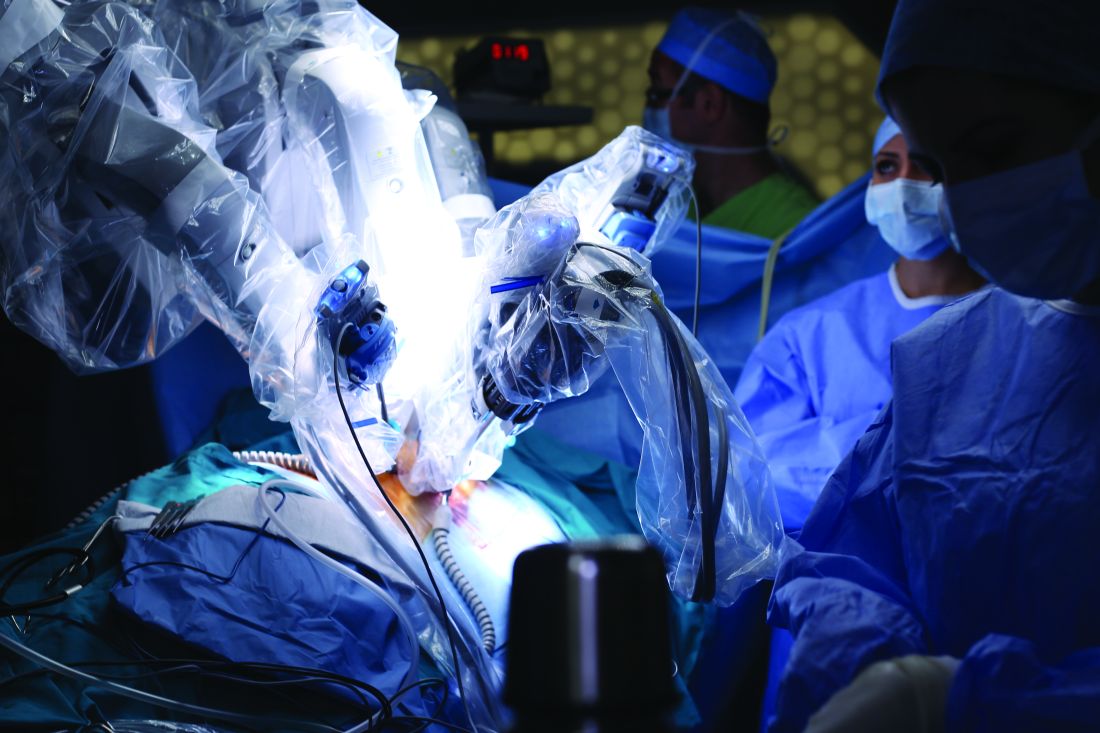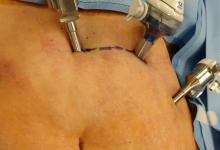User login
Clinical trial: The Role of the Robotic Platform in Inguinal Hernia Repair Surgery
The Role of the Robotic Platform in Inguinal Hernia Repair Surgery is an interventional trial currently recruiting patients who require inguinal hernia repair surgery.
The trial will compare postoperative pain in patients undergoing laparoscopic inguinal hernia surgery repair or robotic inguinal hernia repair surgery. The laparoscopic approach has been used frequently and has several advantages. However, it has several disadvantages that the robotic approach may address. As such, the study investigators have hypothesized that the robotic approach will result in less postoperative pain than the laparoscopic approach.
The primary outcome measure is the difference in postoperative pain between patients who undergo robotic inguinal hernia repair and those who undergo laparoscopic inguinal hernia repair during the 2 years following surgery. Secondary outcome measures include differences in surgeon ergonomics between the two approaches, institution cost analysis, and long-term recurrence rate differences, all within 2 years of surgery.
The study will end in May 2019. About 100 people are expected to be included in the final analysis.
Find more information on the study page at Clinicaltrials.gov.
SOURCE: Clinicaltrials.gov. NCT02816658.
The Role of the Robotic Platform in Inguinal Hernia Repair Surgery is an interventional trial currently recruiting patients who require inguinal hernia repair surgery.
The trial will compare postoperative pain in patients undergoing laparoscopic inguinal hernia surgery repair or robotic inguinal hernia repair surgery. The laparoscopic approach has been used frequently and has several advantages. However, it has several disadvantages that the robotic approach may address. As such, the study investigators have hypothesized that the robotic approach will result in less postoperative pain than the laparoscopic approach.
The primary outcome measure is the difference in postoperative pain between patients who undergo robotic inguinal hernia repair and those who undergo laparoscopic inguinal hernia repair during the 2 years following surgery. Secondary outcome measures include differences in surgeon ergonomics between the two approaches, institution cost analysis, and long-term recurrence rate differences, all within 2 years of surgery.
The study will end in May 2019. About 100 people are expected to be included in the final analysis.
Find more information on the study page at Clinicaltrials.gov.
SOURCE: Clinicaltrials.gov. NCT02816658.
The Role of the Robotic Platform in Inguinal Hernia Repair Surgery is an interventional trial currently recruiting patients who require inguinal hernia repair surgery.
The trial will compare postoperative pain in patients undergoing laparoscopic inguinal hernia surgery repair or robotic inguinal hernia repair surgery. The laparoscopic approach has been used frequently and has several advantages. However, it has several disadvantages that the robotic approach may address. As such, the study investigators have hypothesized that the robotic approach will result in less postoperative pain than the laparoscopic approach.
The primary outcome measure is the difference in postoperative pain between patients who undergo robotic inguinal hernia repair and those who undergo laparoscopic inguinal hernia repair during the 2 years following surgery. Secondary outcome measures include differences in surgeon ergonomics between the two approaches, institution cost analysis, and long-term recurrence rate differences, all within 2 years of surgery.
The study will end in May 2019. About 100 people are expected to be included in the final analysis.
Find more information on the study page at Clinicaltrials.gov.
SOURCE: Clinicaltrials.gov. NCT02816658.
FROM CLINICALTRIALS.GOV
Clinical trial: Study underway of robot-assisted surgery for pelvic prolapse
Robotic Assisted Sacral Colpopexy: A Prospective Study Assessing Outcomes With Learning Curves is an open-label study that is being conducted on a new pelvic floor program for women with pelvic organ prolapse.
A prospective cohort of 100 patients will be recruited and the study will assess surgical time (total and specific essential portions), simulator training, and observed surgeon skills. Secondary endpoints include subjective outcomes for issues of sexual function and incontinence and adverse events such as genitourinary injury, blood loss, wound infection, and mesh erosion.
Kaiser Permanente is the trial sponsor, and patients aged 18-80 years who are undergoing robotic-assisted laparoscopic sacrocolpopexy with or without other procedures for pelvic organ prolapse are being recruited. For more details about the trial, visit https://goo.gl/pWq7qe.
SOURCE: ClinicalTrials.gov: NCT01535833.
Robotic Assisted Sacral Colpopexy: A Prospective Study Assessing Outcomes With Learning Curves is an open-label study that is being conducted on a new pelvic floor program for women with pelvic organ prolapse.
A prospective cohort of 100 patients will be recruited and the study will assess surgical time (total and specific essential portions), simulator training, and observed surgeon skills. Secondary endpoints include subjective outcomes for issues of sexual function and incontinence and adverse events such as genitourinary injury, blood loss, wound infection, and mesh erosion.
Kaiser Permanente is the trial sponsor, and patients aged 18-80 years who are undergoing robotic-assisted laparoscopic sacrocolpopexy with or without other procedures for pelvic organ prolapse are being recruited. For more details about the trial, visit https://goo.gl/pWq7qe.
SOURCE: ClinicalTrials.gov: NCT01535833.
Robotic Assisted Sacral Colpopexy: A Prospective Study Assessing Outcomes With Learning Curves is an open-label study that is being conducted on a new pelvic floor program for women with pelvic organ prolapse.
A prospective cohort of 100 patients will be recruited and the study will assess surgical time (total and specific essential portions), simulator training, and observed surgeon skills. Secondary endpoints include subjective outcomes for issues of sexual function and incontinence and adverse events such as genitourinary injury, blood loss, wound infection, and mesh erosion.
Kaiser Permanente is the trial sponsor, and patients aged 18-80 years who are undergoing robotic-assisted laparoscopic sacrocolpopexy with or without other procedures for pelvic organ prolapse are being recruited. For more details about the trial, visit https://goo.gl/pWq7qe.
SOURCE: ClinicalTrials.gov: NCT01535833.
SUMMARY FROM CLINICALTRIALS.GOV
Robotic hysterectomy plus mini-lap outperformed open procedure
NATIONAL HARBOR, MD. – Robotic hysterectomy combined with extraction of the uterus via mini-laparotomy led to significantly shorter lengths of stay, lower estimated blood loss, and fewer postoperative complications compared with open hysterectomy when the uterus weighed more than 250 grams.
Gynecologic surgeons are seeking ways to safely perform minimally invasive hysterectomy on patients with larger uteri in light of the 2014 Food and Drug Administration admonition regarding power morcellation. To this end, Natasha Gupta, MD, and her colleagues at the University of Tennessee, Chattanooga, retrospectively reviewed all patients with uterine sizes larger than 250 grams undergoing hysterectomy at their institution between 2012 and 2015.
“For the mini-laparotomy, the technique utilizes a customized incision connecting the two left port sites, followed by the removal of the specimen via this incision,” Dr. Gupta said at the AAGL Global Congress.
Patient factors and outcomes were compared via Student t-tests and Chi-square analysis.
Mean length of stay was significantly shorter for patients who underwent robotic hysterectomy/mini-laparotomy, at 1.4 days vs. 5.4 days for those with open hysterectomy (P = .000) as was mean estimated blood loss – 119.9 mL vs. 547.5 mL, respectively (P = .000). Postoperative complications were seen in fewer patients who underwent robotic hysterectomy/mini-laparotomy, 9 of 82 patients vs. 15 of 58 open hysterectomy patients.
Mean operative time was significantly longer in robotic hysterectomy/mini-laparotomy patients – 191.6 minutes vs. 162.8 minutes (P = .005) – but that was expected, Dr. Gupta noted. Patient factors such as hypertension, diabetes, history of spontaneous vaginal delivery and/or cesarean delivery, and body mass index, as well as uterine pathology, were not significantly different between the groups.
“Mini-laparotomy combined with minimally invasive hysterectomy is a very safe and feasible technique for tissue extraction where contained morcellation is either not preferred or not available,” Dr. Gupta said.
Dr. Gupta reported having no relevant financial conflicts of interest.
dfulton@frontlinemedcom.com
On Twitter @denisefulton
NATIONAL HARBOR, MD. – Robotic hysterectomy combined with extraction of the uterus via mini-laparotomy led to significantly shorter lengths of stay, lower estimated blood loss, and fewer postoperative complications compared with open hysterectomy when the uterus weighed more than 250 grams.
Gynecologic surgeons are seeking ways to safely perform minimally invasive hysterectomy on patients with larger uteri in light of the 2014 Food and Drug Administration admonition regarding power morcellation. To this end, Natasha Gupta, MD, and her colleagues at the University of Tennessee, Chattanooga, retrospectively reviewed all patients with uterine sizes larger than 250 grams undergoing hysterectomy at their institution between 2012 and 2015.
“For the mini-laparotomy, the technique utilizes a customized incision connecting the two left port sites, followed by the removal of the specimen via this incision,” Dr. Gupta said at the AAGL Global Congress.
Patient factors and outcomes were compared via Student t-tests and Chi-square analysis.
Mean length of stay was significantly shorter for patients who underwent robotic hysterectomy/mini-laparotomy, at 1.4 days vs. 5.4 days for those with open hysterectomy (P = .000) as was mean estimated blood loss – 119.9 mL vs. 547.5 mL, respectively (P = .000). Postoperative complications were seen in fewer patients who underwent robotic hysterectomy/mini-laparotomy, 9 of 82 patients vs. 15 of 58 open hysterectomy patients.
Mean operative time was significantly longer in robotic hysterectomy/mini-laparotomy patients – 191.6 minutes vs. 162.8 minutes (P = .005) – but that was expected, Dr. Gupta noted. Patient factors such as hypertension, diabetes, history of spontaneous vaginal delivery and/or cesarean delivery, and body mass index, as well as uterine pathology, were not significantly different between the groups.
“Mini-laparotomy combined with minimally invasive hysterectomy is a very safe and feasible technique for tissue extraction where contained morcellation is either not preferred or not available,” Dr. Gupta said.
Dr. Gupta reported having no relevant financial conflicts of interest.
dfulton@frontlinemedcom.com
On Twitter @denisefulton
NATIONAL HARBOR, MD. – Robotic hysterectomy combined with extraction of the uterus via mini-laparotomy led to significantly shorter lengths of stay, lower estimated blood loss, and fewer postoperative complications compared with open hysterectomy when the uterus weighed more than 250 grams.
Gynecologic surgeons are seeking ways to safely perform minimally invasive hysterectomy on patients with larger uteri in light of the 2014 Food and Drug Administration admonition regarding power morcellation. To this end, Natasha Gupta, MD, and her colleagues at the University of Tennessee, Chattanooga, retrospectively reviewed all patients with uterine sizes larger than 250 grams undergoing hysterectomy at their institution between 2012 and 2015.
“For the mini-laparotomy, the technique utilizes a customized incision connecting the two left port sites, followed by the removal of the specimen via this incision,” Dr. Gupta said at the AAGL Global Congress.
Patient factors and outcomes were compared via Student t-tests and Chi-square analysis.
Mean length of stay was significantly shorter for patients who underwent robotic hysterectomy/mini-laparotomy, at 1.4 days vs. 5.4 days for those with open hysterectomy (P = .000) as was mean estimated blood loss – 119.9 mL vs. 547.5 mL, respectively (P = .000). Postoperative complications were seen in fewer patients who underwent robotic hysterectomy/mini-laparotomy, 9 of 82 patients vs. 15 of 58 open hysterectomy patients.
Mean operative time was significantly longer in robotic hysterectomy/mini-laparotomy patients – 191.6 minutes vs. 162.8 minutes (P = .005) – but that was expected, Dr. Gupta noted. Patient factors such as hypertension, diabetes, history of spontaneous vaginal delivery and/or cesarean delivery, and body mass index, as well as uterine pathology, were not significantly different between the groups.
“Mini-laparotomy combined with minimally invasive hysterectomy is a very safe and feasible technique for tissue extraction where contained morcellation is either not preferred or not available,” Dr. Gupta said.
Dr. Gupta reported having no relevant financial conflicts of interest.
dfulton@frontlinemedcom.com
On Twitter @denisefulton
AT AAGL 2017
Key clinical point:
Major finding: Mean length of stay was 1.4 days with robotic hysterectomy/mini-laparotomy vs. 5.4 days for open hysterectomy (P = .000).
Data source: A single-center retrospective review of all hysterectomies with uteri larger than 250 grams from the period of 2012-2015.
Disclosures: The study had no outside funding. Dr. Gupta reported having no relevant conflicts of interest.
Robotic Nissen fundoplication has teaching advantages
Training level affected operative time for laparoscopic Nissen fundoplication, but not for the robotic procedure, according to Maureen D. Moore, MD, and her associates.
Further, in laparoscopic and robotic procedures, junior and senior assistant cohorts had similar outcome measures for estimated blood loss, length of stay, postoperative complications, and 30-day readmission rate.
“The robotic technique offers unique advantages as an educational platform and potentially allows for increased trainee participation without compromising perioperative outcomes,” researchers concluded.
They evaluated surgical times and outcomes for 105 patients; junior assistants (postgraduate year-3 surgery residents) were present in 29 laparoscopic and 44 robotic procedures and senior assistants (minimally invasive surgery fellows) assisted in 18 laparoscopic and 14 robotic procedures.
Median operative time was significantly shorter for the laparoscopic procedures, 112 minutes vs. 157 minutes for the robotic procedures (P less than 0.001). Plus, the median operative time was significantly lower when senior assistants were involved in the laparoscopic procedures, 85 minutes vs. 129 minutes for the junior assistants (P = 0.02).
For the robotic procedures, the median operative times were not significantly different based on the assistant’s level of training, 154 minutes vs. 158 minutes.
Read the full study in the Journal of Surgical Research (doi: 10.1016/j.jss.2017.05.127).
Training level affected operative time for laparoscopic Nissen fundoplication, but not for the robotic procedure, according to Maureen D. Moore, MD, and her associates.
Further, in laparoscopic and robotic procedures, junior and senior assistant cohorts had similar outcome measures for estimated blood loss, length of stay, postoperative complications, and 30-day readmission rate.
“The robotic technique offers unique advantages as an educational platform and potentially allows for increased trainee participation without compromising perioperative outcomes,” researchers concluded.
They evaluated surgical times and outcomes for 105 patients; junior assistants (postgraduate year-3 surgery residents) were present in 29 laparoscopic and 44 robotic procedures and senior assistants (minimally invasive surgery fellows) assisted in 18 laparoscopic and 14 robotic procedures.
Median operative time was significantly shorter for the laparoscopic procedures, 112 minutes vs. 157 minutes for the robotic procedures (P less than 0.001). Plus, the median operative time was significantly lower when senior assistants were involved in the laparoscopic procedures, 85 minutes vs. 129 minutes for the junior assistants (P = 0.02).
For the robotic procedures, the median operative times were not significantly different based on the assistant’s level of training, 154 minutes vs. 158 minutes.
Read the full study in the Journal of Surgical Research (doi: 10.1016/j.jss.2017.05.127).
Training level affected operative time for laparoscopic Nissen fundoplication, but not for the robotic procedure, according to Maureen D. Moore, MD, and her associates.
Further, in laparoscopic and robotic procedures, junior and senior assistant cohorts had similar outcome measures for estimated blood loss, length of stay, postoperative complications, and 30-day readmission rate.
“The robotic technique offers unique advantages as an educational platform and potentially allows for increased trainee participation without compromising perioperative outcomes,” researchers concluded.
They evaluated surgical times and outcomes for 105 patients; junior assistants (postgraduate year-3 surgery residents) were present in 29 laparoscopic and 44 robotic procedures and senior assistants (minimally invasive surgery fellows) assisted in 18 laparoscopic and 14 robotic procedures.
Median operative time was significantly shorter for the laparoscopic procedures, 112 minutes vs. 157 minutes for the robotic procedures (P less than 0.001). Plus, the median operative time was significantly lower when senior assistants were involved in the laparoscopic procedures, 85 minutes vs. 129 minutes for the junior assistants (P = 0.02).
For the robotic procedures, the median operative times were not significantly different based on the assistant’s level of training, 154 minutes vs. 158 minutes.
Read the full study in the Journal of Surgical Research (doi: 10.1016/j.jss.2017.05.127).
FROM THE JOURNAL OF SURGICAL RESEARCH
Shorter hospital stays with robotic thoracic surgery
Robotic thoracic surgery is associated with shorter hospital stays, shorter duration of chest tube usage, and lower postoperative pain intensity than open thoracotomy, new data suggests.
In a paper published in Surgical Endoscopy, researchers reported the results of a retrospective study comparing the outcomes from 38 individuals who underwent robotic thoracic surgery using the da Vinci System with those of 38 patients who underwent open thoracic surgery.
They saw significantly shorter hospital stays associated with robotic surgery, compared with open surgery (6.9 days vs. 8.0 days, respectively; P = .02), as well as a shorter duration of chest tube use (2.9 plus or minus 2.0 days vs. 4.9 plus or minus 2.2 days; P less than .001).
While robotic surgery did not result in significant reductions in postoperative pain intensity when patients coughed, pain intensity for patients at rest on days 4 and 5 after surgery was significantly lower among those who had undergone robotic surgery than among those who had undergone open surgery (Surg Endosc. 2017. doi: 10.1007/s00464-017-5464-6). On day 4, those who had undergone robotic surgery reported a mean pain score of 0.5 on a scale of 1-10, while those who underwent open surgery had a mean pain score of 1.1 (P = .04). On day 5, the mean pain scores were 0.7 in the robotic-surgery group and 1.6 in the open-surgery group (P = .003).
However, there was no difference in postoperative opioid use between the two groups. The robotic-surgery group showed a trend toward more postoperative nausea, but this did not reach statistical significance.
Most of the surgeries in the study were performed to remove malignant or benign tumors. Among both groups, 68% of patients received epidural analgesia, and 32% received systemic opioid-based postoperative analgesia.
“Current evidence shows that more than 70% of stage I lung cancers are still being performed by open technique,” wrote Christopher Darr, from the West German Lung Center at University Hospital Essen (Germany), and his coauthors. “However, the safety and the feasibility of robotic anatomic lung resection have been shown in several case series. Robotic thoracic surgery is gaining popularity as benefits can be suggested, such as improved ergonomics, three-dimensional optics, and simplifying operative procedure.”
One author declared financial support for meetings and presentations from Intuitive Surgical, the company that developed the da Vinci System. No other conflicts of interest were declared.
Robotic thoracic surgery is associated with shorter hospital stays, shorter duration of chest tube usage, and lower postoperative pain intensity than open thoracotomy, new data suggests.
In a paper published in Surgical Endoscopy, researchers reported the results of a retrospective study comparing the outcomes from 38 individuals who underwent robotic thoracic surgery using the da Vinci System with those of 38 patients who underwent open thoracic surgery.
They saw significantly shorter hospital stays associated with robotic surgery, compared with open surgery (6.9 days vs. 8.0 days, respectively; P = .02), as well as a shorter duration of chest tube use (2.9 plus or minus 2.0 days vs. 4.9 plus or minus 2.2 days; P less than .001).
While robotic surgery did not result in significant reductions in postoperative pain intensity when patients coughed, pain intensity for patients at rest on days 4 and 5 after surgery was significantly lower among those who had undergone robotic surgery than among those who had undergone open surgery (Surg Endosc. 2017. doi: 10.1007/s00464-017-5464-6). On day 4, those who had undergone robotic surgery reported a mean pain score of 0.5 on a scale of 1-10, while those who underwent open surgery had a mean pain score of 1.1 (P = .04). On day 5, the mean pain scores were 0.7 in the robotic-surgery group and 1.6 in the open-surgery group (P = .003).
However, there was no difference in postoperative opioid use between the two groups. The robotic-surgery group showed a trend toward more postoperative nausea, but this did not reach statistical significance.
Most of the surgeries in the study were performed to remove malignant or benign tumors. Among both groups, 68% of patients received epidural analgesia, and 32% received systemic opioid-based postoperative analgesia.
“Current evidence shows that more than 70% of stage I lung cancers are still being performed by open technique,” wrote Christopher Darr, from the West German Lung Center at University Hospital Essen (Germany), and his coauthors. “However, the safety and the feasibility of robotic anatomic lung resection have been shown in several case series. Robotic thoracic surgery is gaining popularity as benefits can be suggested, such as improved ergonomics, three-dimensional optics, and simplifying operative procedure.”
One author declared financial support for meetings and presentations from Intuitive Surgical, the company that developed the da Vinci System. No other conflicts of interest were declared.
Robotic thoracic surgery is associated with shorter hospital stays, shorter duration of chest tube usage, and lower postoperative pain intensity than open thoracotomy, new data suggests.
In a paper published in Surgical Endoscopy, researchers reported the results of a retrospective study comparing the outcomes from 38 individuals who underwent robotic thoracic surgery using the da Vinci System with those of 38 patients who underwent open thoracic surgery.
They saw significantly shorter hospital stays associated with robotic surgery, compared with open surgery (6.9 days vs. 8.0 days, respectively; P = .02), as well as a shorter duration of chest tube use (2.9 plus or minus 2.0 days vs. 4.9 plus or minus 2.2 days; P less than .001).
While robotic surgery did not result in significant reductions in postoperative pain intensity when patients coughed, pain intensity for patients at rest on days 4 and 5 after surgery was significantly lower among those who had undergone robotic surgery than among those who had undergone open surgery (Surg Endosc. 2017. doi: 10.1007/s00464-017-5464-6). On day 4, those who had undergone robotic surgery reported a mean pain score of 0.5 on a scale of 1-10, while those who underwent open surgery had a mean pain score of 1.1 (P = .04). On day 5, the mean pain scores were 0.7 in the robotic-surgery group and 1.6 in the open-surgery group (P = .003).
However, there was no difference in postoperative opioid use between the two groups. The robotic-surgery group showed a trend toward more postoperative nausea, but this did not reach statistical significance.
Most of the surgeries in the study were performed to remove malignant or benign tumors. Among both groups, 68% of patients received epidural analgesia, and 32% received systemic opioid-based postoperative analgesia.
“Current evidence shows that more than 70% of stage I lung cancers are still being performed by open technique,” wrote Christopher Darr, from the West German Lung Center at University Hospital Essen (Germany), and his coauthors. “However, the safety and the feasibility of robotic anatomic lung resection have been shown in several case series. Robotic thoracic surgery is gaining popularity as benefits can be suggested, such as improved ergonomics, three-dimensional optics, and simplifying operative procedure.”
One author declared financial support for meetings and presentations from Intuitive Surgical, the company that developed the da Vinci System. No other conflicts of interest were declared.
FROM SURGICAL ENDOSCOPY
Key clinical point: Robotic thoracic surgery is associated with shorter hospital stays and shorter duration of chest tube use, compared with open surgery.
Major finding: Patients who underwent robotic thoracic surgery had a mean hospital stay of 6.9 days, compared with 8 days for those who underwent open thoracic surgery.
Data source: Retrospective study of 38 patients who underwent robotic thoracic surgery and 38 who underwent open thoracic surgery.
Disclosures: One investigator declared financial support from Intuitive Surgical, the company that developed the da Vinci System, for meetings and presentations. No other conflicts of interest were declared.
Robotic guide hits the mark in abdominal surgeries
More than 90% of the image-based movements of a new robotic camera steering device were accurate in a study of 66 procedures sponsored by the device maker. The findings were published online in Surgical Endoscopy.
“A robotic laparoscopic positioner can perform the task of the surgical assistant and enables the surgeon to control camera movements personally,” wrote Paul J. M. Wijsman, MD, of Meander Medical Center, Amersfoort, the Netherlands, and colleagues (Surg. Endosc 2017. doi: 10.1007/s00464-017-5957-3).
To assess the accuracy of an image-guided robotic control system (AutoLap, MST, Israel), the researchers conducted a multicenter study of patients scheduled for abdominal surgeries including hernia repair and gallbladder removal. The primary outcomes were the number of successful movements and adverse events. The average age of the patients was 49 years, and approximately 75% were women.
“A movement is deemed successful if the laparoscope reached the desired position, which was verbally verified with the surgeon after each movement,” the researchers wrote. An average of 99 joystick movements and 12.8 “follow-me” movements were made during a procedure. The nine surgeons who participated in the study reported an average satisfaction of 4 on a scale of 1-5. Overall, no adverse events related to the procedures were reported.
The operational times using the robotic device were consistent with previous studies, the researchers said. The average time to set up the system was 4 minutes.
The findings were limited by several factors, including the limitations of the system and possible bias of the participants; factors affecting image quality included fogging and blurring of the lens, the researchers said. However, the results suggest that a robotic system such as AutoLap may have economic value by reducing the number of surgical team members needed for a procedure, and more research is needed to determine both economic and ergonomic benefits, they noted.
The study was sponsored by MST – Medical Surgery Technologies. Dr. Wijsman is a clinical field engineer for the company.
More than 90% of the image-based movements of a new robotic camera steering device were accurate in a study of 66 procedures sponsored by the device maker. The findings were published online in Surgical Endoscopy.
“A robotic laparoscopic positioner can perform the task of the surgical assistant and enables the surgeon to control camera movements personally,” wrote Paul J. M. Wijsman, MD, of Meander Medical Center, Amersfoort, the Netherlands, and colleagues (Surg. Endosc 2017. doi: 10.1007/s00464-017-5957-3).
To assess the accuracy of an image-guided robotic control system (AutoLap, MST, Israel), the researchers conducted a multicenter study of patients scheduled for abdominal surgeries including hernia repair and gallbladder removal. The primary outcomes were the number of successful movements and adverse events. The average age of the patients was 49 years, and approximately 75% were women.
“A movement is deemed successful if the laparoscope reached the desired position, which was verbally verified with the surgeon after each movement,” the researchers wrote. An average of 99 joystick movements and 12.8 “follow-me” movements were made during a procedure. The nine surgeons who participated in the study reported an average satisfaction of 4 on a scale of 1-5. Overall, no adverse events related to the procedures were reported.
The operational times using the robotic device were consistent with previous studies, the researchers said. The average time to set up the system was 4 minutes.
The findings were limited by several factors, including the limitations of the system and possible bias of the participants; factors affecting image quality included fogging and blurring of the lens, the researchers said. However, the results suggest that a robotic system such as AutoLap may have economic value by reducing the number of surgical team members needed for a procedure, and more research is needed to determine both economic and ergonomic benefits, they noted.
The study was sponsored by MST – Medical Surgery Technologies. Dr. Wijsman is a clinical field engineer for the company.
More than 90% of the image-based movements of a new robotic camera steering device were accurate in a study of 66 procedures sponsored by the device maker. The findings were published online in Surgical Endoscopy.
“A robotic laparoscopic positioner can perform the task of the surgical assistant and enables the surgeon to control camera movements personally,” wrote Paul J. M. Wijsman, MD, of Meander Medical Center, Amersfoort, the Netherlands, and colleagues (Surg. Endosc 2017. doi: 10.1007/s00464-017-5957-3).
To assess the accuracy of an image-guided robotic control system (AutoLap, MST, Israel), the researchers conducted a multicenter study of patients scheduled for abdominal surgeries including hernia repair and gallbladder removal. The primary outcomes were the number of successful movements and adverse events. The average age of the patients was 49 years, and approximately 75% were women.
“A movement is deemed successful if the laparoscope reached the desired position, which was verbally verified with the surgeon after each movement,” the researchers wrote. An average of 99 joystick movements and 12.8 “follow-me” movements were made during a procedure. The nine surgeons who participated in the study reported an average satisfaction of 4 on a scale of 1-5. Overall, no adverse events related to the procedures were reported.
The operational times using the robotic device were consistent with previous studies, the researchers said. The average time to set up the system was 4 minutes.
The findings were limited by several factors, including the limitations of the system and possible bias of the participants; factors affecting image quality included fogging and blurring of the lens, the researchers said. However, the results suggest that a robotic system such as AutoLap may have economic value by reducing the number of surgical team members needed for a procedure, and more research is needed to determine both economic and ergonomic benefits, they noted.
The study was sponsored by MST – Medical Surgery Technologies. Dr. Wijsman is a clinical field engineer for the company.
FROM SURGICAL ENDOSCOPY
Key clinical point: The Autolap system was a safe and effective way to manage a robotic camera during a range of abdominal surgical procedures.
Major finding: An image-based steering device for a robotic camera was accurate more than 90% of the time when used to guide surgeons.
Data source: The data come from a review of 66 abdominal surgeries in adults.
Disclosures: The study was sponsored by MST – Medical Surgery Technologies – maker of the device. Dr. Wijsman is a clinical field engineer for the company.
Robotic-assisted pulmonary lobectomy effective for large tumors
Robotic-assisted pulmonary lobectomy is a safe and effective way to remove large tumors in patients with non–small cell lung cancer (NSCLC), according to the abstract of a study scheduled to be presented at the CHEST annual meeting.
The study covers a retrospective analysis of 345 NSCLC patients with tumors who underwent robotic-assisted pulmonary lobectomy performed by one surgeon from September 2010 through August 2016. The participants were grouped into the following three cohorts: patients with tumors less than 5 cm in diameter, patients with tumors from 5 to 7 cm, and patients with tumors larger than 7 cm. The researchers excluded patients with pulmonary metastases or benign lesions from the study.
Patients with smaller tumors were more likely to have simple lobectomy or lobectomy plus wedge, while patients with larger tumors were more likely to require lobectomy with chest wall resection. Increased tumor size was also associated with increased intraoperative estimated blood loss, skin-to-skin operative time, hospital length of stay, and overall conversion to open lobectomy.
There was no association found between tumor size and increased overall intraoperative or postoperative complications, or in-hospital mortality.
Nirav Patel, MD, FCCP, of the Tampa Bay Sleep Center is scheduled to present his abstract on Sunday Oct. 29th, between 2:15 and 2:30 p.m. in Convention Center – 606. Dr. Patel’s research is part of the Cardiothoracic Surgery session, running from 1:30 p.m. to 3:00 p.m. at the CHEST annual meeting.
Robotic-assisted pulmonary lobectomy is a safe and effective way to remove large tumors in patients with non–small cell lung cancer (NSCLC), according to the abstract of a study scheduled to be presented at the CHEST annual meeting.
The study covers a retrospective analysis of 345 NSCLC patients with tumors who underwent robotic-assisted pulmonary lobectomy performed by one surgeon from September 2010 through August 2016. The participants were grouped into the following three cohorts: patients with tumors less than 5 cm in diameter, patients with tumors from 5 to 7 cm, and patients with tumors larger than 7 cm. The researchers excluded patients with pulmonary metastases or benign lesions from the study.
Patients with smaller tumors were more likely to have simple lobectomy or lobectomy plus wedge, while patients with larger tumors were more likely to require lobectomy with chest wall resection. Increased tumor size was also associated with increased intraoperative estimated blood loss, skin-to-skin operative time, hospital length of stay, and overall conversion to open lobectomy.
There was no association found between tumor size and increased overall intraoperative or postoperative complications, or in-hospital mortality.
Nirav Patel, MD, FCCP, of the Tampa Bay Sleep Center is scheduled to present his abstract on Sunday Oct. 29th, between 2:15 and 2:30 p.m. in Convention Center – 606. Dr. Patel’s research is part of the Cardiothoracic Surgery session, running from 1:30 p.m. to 3:00 p.m. at the CHEST annual meeting.
Robotic-assisted pulmonary lobectomy is a safe and effective way to remove large tumors in patients with non–small cell lung cancer (NSCLC), according to the abstract of a study scheduled to be presented at the CHEST annual meeting.
The study covers a retrospective analysis of 345 NSCLC patients with tumors who underwent robotic-assisted pulmonary lobectomy performed by one surgeon from September 2010 through August 2016. The participants were grouped into the following three cohorts: patients with tumors less than 5 cm in diameter, patients with tumors from 5 to 7 cm, and patients with tumors larger than 7 cm. The researchers excluded patients with pulmonary metastases or benign lesions from the study.
Patients with smaller tumors were more likely to have simple lobectomy or lobectomy plus wedge, while patients with larger tumors were more likely to require lobectomy with chest wall resection. Increased tumor size was also associated with increased intraoperative estimated blood loss, skin-to-skin operative time, hospital length of stay, and overall conversion to open lobectomy.
There was no association found between tumor size and increased overall intraoperative or postoperative complications, or in-hospital mortality.
Nirav Patel, MD, FCCP, of the Tampa Bay Sleep Center is scheduled to present his abstract on Sunday Oct. 29th, between 2:15 and 2:30 p.m. in Convention Center – 606. Dr. Patel’s research is part of the Cardiothoracic Surgery session, running from 1:30 p.m. to 3:00 p.m. at the CHEST annual meeting.
FROM CHEST 2017
Clinical Trial Summary: Ergonomics of robotic surgery
The Ergonomics in Robotic Surgery clinical trial is being conducted to study the role of ergonomics in adjusting robotic surgery consoles to individual body types of operators. The study will look at comfort and physical support of gynecologic surgeons after performing a hysterectomy using a da Vinci robotic surgery console. One group of surgeons will adjust their own console and another group will have the console adjusted by an ergonomist.
For a further description of the study, go to www.clinicaltrials.gov.
tborden@frontlinemedcom.com
On Twitter @ThereseBorden
The Ergonomics in Robotic Surgery clinical trial is being conducted to study the role of ergonomics in adjusting robotic surgery consoles to individual body types of operators. The study will look at comfort and physical support of gynecologic surgeons after performing a hysterectomy using a da Vinci robotic surgery console. One group of surgeons will adjust their own console and another group will have the console adjusted by an ergonomist.
For a further description of the study, go to www.clinicaltrials.gov.
tborden@frontlinemedcom.com
On Twitter @ThereseBorden
The Ergonomics in Robotic Surgery clinical trial is being conducted to study the role of ergonomics in adjusting robotic surgery consoles to individual body types of operators. The study will look at comfort and physical support of gynecologic surgeons after performing a hysterectomy using a da Vinci robotic surgery console. One group of surgeons will adjust their own console and another group will have the console adjusted by an ergonomist.
For a further description of the study, go to www.clinicaltrials.gov.
tborden@frontlinemedcom.com
On Twitter @ThereseBorden
FROM CLINICALTRIALS.GOV
Robot-assisted abdominoperineal resection outperforms open or laparoscopic surgery for rectal cancers
MADRID – The automaton uprising continues: Robot-assisted abdominoperineal resection (APR) can be safely performed in patients with rectal cancers within 5 cm of the anal verge, with surgical results equivalent to those seen with open or laparoscopic APR, investigators say.
Robot-assisted procedures were associated with a significantly lower rate of postoperative complications and with faster functional recovery than either laparoscopic or open surgery in a randomized trial, reported Jianmin Xu, MD, PhD., from Fudan University in Shanghai, China, and colleagues in a scientific poster presented at the European Society for Medical Oncology Congress.
“Retrospective studies have showed that robotic surgery was better than laparoscopic surgery in ensuring radical resection, reducing complications, and promoting recovery. However, there is no clinical trial reported for robotic surgery for rectal cancer. Thus, we conduct this randomized controlled trial to compare the safety and efficacy of robotic, laparoscopic, and open surgery for low rectal cancer,” they wrote.
Dr. Xu and colleagues enrolled 506 patients from 18 to 75 years of age with clinical stage T1 to T3 cancers within 5 cm of the anal verge and no distant metastases and randomly assigned them to resection with either a robot-assisted, laparoscopic, or open APR technique. Three of the 506 patients randomized did not undergo resection, leaving 503 for the per-protocol analysis presented here.
For the primary endpoint of complications rates within 30 days following surgery, the investigators found that patients assigned to robotic-assisted surgery (173 patients) had a total complication rate of 10.4%, compared with 18.8% for 176 patients assigned to laparoscopy (P = .027), and 26% for 154 assigned to open APR (P less than .001). The latter group included four patients assigned to laparoscopy whose procedures were converted to open surgery.
Among patients without complications, robot-assisted procedures were also associated with faster recovery, as measured by days to first flatus, at a median of 1 vs. 2 for laparoscopy and 3 for open procedures (P less than .001 for robots vs. each other surgery type). The robotic surgery was also significantly associated with fewer days to first automatic urination (median 2 vs. 4 for each of the other procedures; P less than .001), and with fewer days to discharge (median 5 vs. 7 for the other procedures; P less than .001).
"These are excellent postoperative complication rates reported, especially for the robotic treatment group, commented Thomas Gruenberger, MD, an oncologic surgeon at Rudolf Hospital in Vienna, in a poster discussion session.
“We all are now favoring laparoscopic surgery for these kinds of patients. The robot is a nice thing to have; however, we cannot use it in every hospital because it’s still quite expensive,” he said.
“We require – and this is a secondary endpoint of the study – long-term follow-up for local and distant outcomes,” he added,
The investigators did not report a funding source. All authors declared having no conflicts of interest. Dr. Gruenberger disclosed research funding, speakers bureau participation, and/or advisory roles with several companies.
MADRID – The automaton uprising continues: Robot-assisted abdominoperineal resection (APR) can be safely performed in patients with rectal cancers within 5 cm of the anal verge, with surgical results equivalent to those seen with open or laparoscopic APR, investigators say.
Robot-assisted procedures were associated with a significantly lower rate of postoperative complications and with faster functional recovery than either laparoscopic or open surgery in a randomized trial, reported Jianmin Xu, MD, PhD., from Fudan University in Shanghai, China, and colleagues in a scientific poster presented at the European Society for Medical Oncology Congress.
“Retrospective studies have showed that robotic surgery was better than laparoscopic surgery in ensuring radical resection, reducing complications, and promoting recovery. However, there is no clinical trial reported for robotic surgery for rectal cancer. Thus, we conduct this randomized controlled trial to compare the safety and efficacy of robotic, laparoscopic, and open surgery for low rectal cancer,” they wrote.
Dr. Xu and colleagues enrolled 506 patients from 18 to 75 years of age with clinical stage T1 to T3 cancers within 5 cm of the anal verge and no distant metastases and randomly assigned them to resection with either a robot-assisted, laparoscopic, or open APR technique. Three of the 506 patients randomized did not undergo resection, leaving 503 for the per-protocol analysis presented here.
For the primary endpoint of complications rates within 30 days following surgery, the investigators found that patients assigned to robotic-assisted surgery (173 patients) had a total complication rate of 10.4%, compared with 18.8% for 176 patients assigned to laparoscopy (P = .027), and 26% for 154 assigned to open APR (P less than .001). The latter group included four patients assigned to laparoscopy whose procedures were converted to open surgery.
Among patients without complications, robot-assisted procedures were also associated with faster recovery, as measured by days to first flatus, at a median of 1 vs. 2 for laparoscopy and 3 for open procedures (P less than .001 for robots vs. each other surgery type). The robotic surgery was also significantly associated with fewer days to first automatic urination (median 2 vs. 4 for each of the other procedures; P less than .001), and with fewer days to discharge (median 5 vs. 7 for the other procedures; P less than .001).
"These are excellent postoperative complication rates reported, especially for the robotic treatment group, commented Thomas Gruenberger, MD, an oncologic surgeon at Rudolf Hospital in Vienna, in a poster discussion session.
“We all are now favoring laparoscopic surgery for these kinds of patients. The robot is a nice thing to have; however, we cannot use it in every hospital because it’s still quite expensive,” he said.
“We require – and this is a secondary endpoint of the study – long-term follow-up for local and distant outcomes,” he added,
The investigators did not report a funding source. All authors declared having no conflicts of interest. Dr. Gruenberger disclosed research funding, speakers bureau participation, and/or advisory roles with several companies.
MADRID – The automaton uprising continues: Robot-assisted abdominoperineal resection (APR) can be safely performed in patients with rectal cancers within 5 cm of the anal verge, with surgical results equivalent to those seen with open or laparoscopic APR, investigators say.
Robot-assisted procedures were associated with a significantly lower rate of postoperative complications and with faster functional recovery than either laparoscopic or open surgery in a randomized trial, reported Jianmin Xu, MD, PhD., from Fudan University in Shanghai, China, and colleagues in a scientific poster presented at the European Society for Medical Oncology Congress.
“Retrospective studies have showed that robotic surgery was better than laparoscopic surgery in ensuring radical resection, reducing complications, and promoting recovery. However, there is no clinical trial reported for robotic surgery for rectal cancer. Thus, we conduct this randomized controlled trial to compare the safety and efficacy of robotic, laparoscopic, and open surgery for low rectal cancer,” they wrote.
Dr. Xu and colleagues enrolled 506 patients from 18 to 75 years of age with clinical stage T1 to T3 cancers within 5 cm of the anal verge and no distant metastases and randomly assigned them to resection with either a robot-assisted, laparoscopic, or open APR technique. Three of the 506 patients randomized did not undergo resection, leaving 503 for the per-protocol analysis presented here.
For the primary endpoint of complications rates within 30 days following surgery, the investigators found that patients assigned to robotic-assisted surgery (173 patients) had a total complication rate of 10.4%, compared with 18.8% for 176 patients assigned to laparoscopy (P = .027), and 26% for 154 assigned to open APR (P less than .001). The latter group included four patients assigned to laparoscopy whose procedures were converted to open surgery.
Among patients without complications, robot-assisted procedures were also associated with faster recovery, as measured by days to first flatus, at a median of 1 vs. 2 for laparoscopy and 3 for open procedures (P less than .001 for robots vs. each other surgery type). The robotic surgery was also significantly associated with fewer days to first automatic urination (median 2 vs. 4 for each of the other procedures; P less than .001), and with fewer days to discharge (median 5 vs. 7 for the other procedures; P less than .001).
"These are excellent postoperative complication rates reported, especially for the robotic treatment group, commented Thomas Gruenberger, MD, an oncologic surgeon at Rudolf Hospital in Vienna, in a poster discussion session.
“We all are now favoring laparoscopic surgery for these kinds of patients. The robot is a nice thing to have; however, we cannot use it in every hospital because it’s still quite expensive,” he said.
“We require – and this is a secondary endpoint of the study – long-term follow-up for local and distant outcomes,” he added,
The investigators did not report a funding source. All authors declared having no conflicts of interest. Dr. Gruenberger disclosed research funding, speakers bureau participation, and/or advisory roles with several companies.
AT ESMO 2017
Transoral robotic surgery assessed for oral lesions
A single-arm study is being conducted at the Ohio State University Comprehensive Cancer Center, Columbus, to assess transoral robotic surgery (TORS) for oral and laryngopharyngeal benign and malignant lesions using the da Vinci Robotic Surgical System.
The study started in 2007, and the estimated completion date is December 2020. Investigators hope to enroll 360 adults.
Patients are scheduled for regular postop visits to assess quality of life and other matters. Those unable to return to Ohio State University are contacted by phone or provided with the questionnaire by mail.
A single-arm study is being conducted at the Ohio State University Comprehensive Cancer Center, Columbus, to assess transoral robotic surgery (TORS) for oral and laryngopharyngeal benign and malignant lesions using the da Vinci Robotic Surgical System.
The study started in 2007, and the estimated completion date is December 2020. Investigators hope to enroll 360 adults.
Patients are scheduled for regular postop visits to assess quality of life and other matters. Those unable to return to Ohio State University are contacted by phone or provided with the questionnaire by mail.
A single-arm study is being conducted at the Ohio State University Comprehensive Cancer Center, Columbus, to assess transoral robotic surgery (TORS) for oral and laryngopharyngeal benign and malignant lesions using the da Vinci Robotic Surgical System.
The study started in 2007, and the estimated completion date is December 2020. Investigators hope to enroll 360 adults.
Patients are scheduled for regular postop visits to assess quality of life and other matters. Those unable to return to Ohio State University are contacted by phone or provided with the questionnaire by mail.







